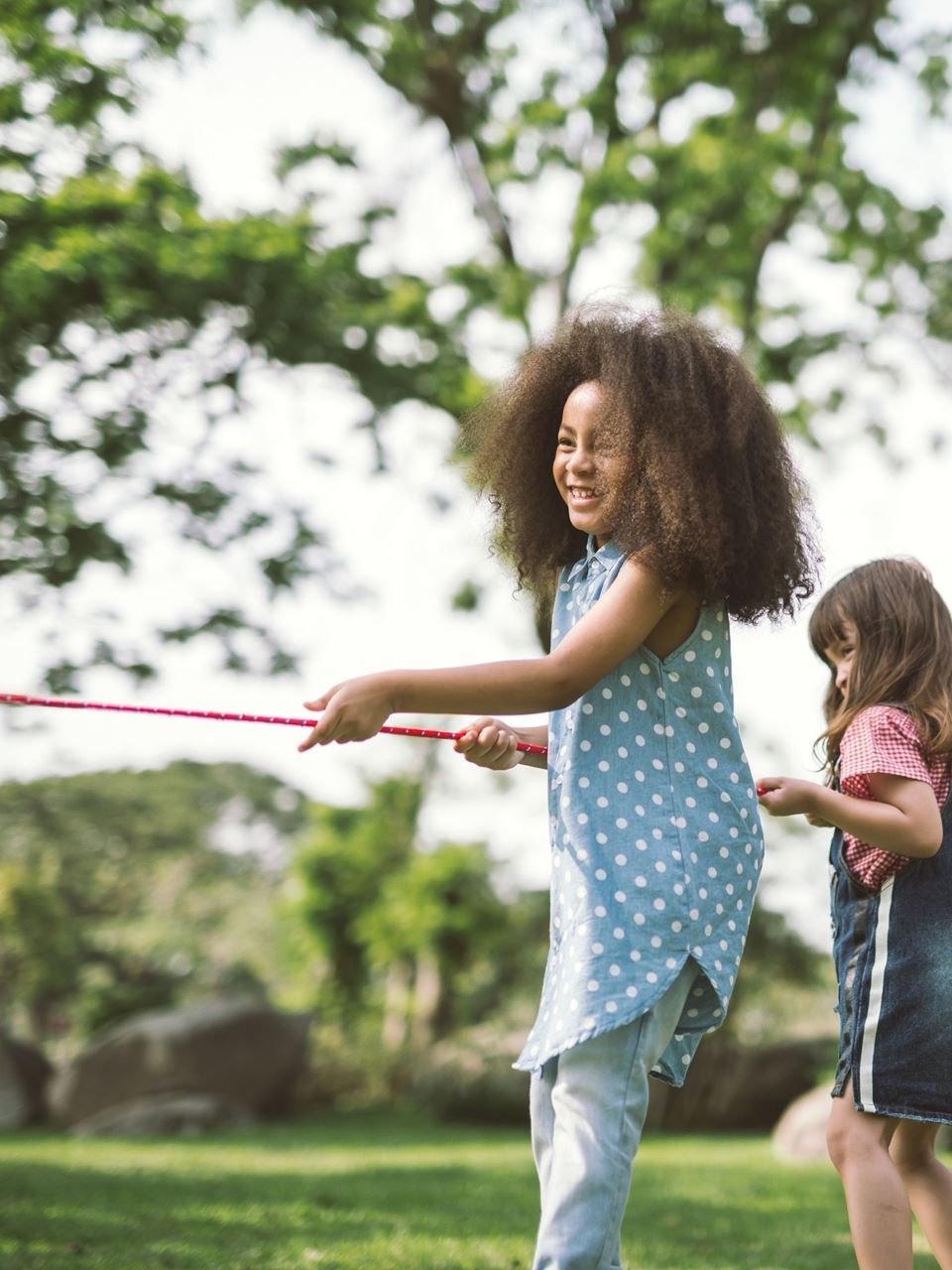Even in times of COVID, perhaps especially in times of COVID, FIGT member and international educator Jacob Huff explains why it is so important to "go play".

By Jacob Huff
While people of all ages can be involved in play activities, children have a unique ability to engage in play and a deep need to learn about themselves and the world around them in this way. Educators and educational researchers have long understood that it is a key element of growth and learning, but in 2013 the United Nations Convention on the Rights of the Child Article 31 established an international understanding of the rights of children to play. While it may seem intuitive, in these strange times, it is important to deeply understand what kinds of play educators and parents can use to meet the needs of the children in our care because life in the age of COVID has brought many new challenges, new questions, and new solutions.
I am an international educator. I am currently the elementary principal of an American curriculum school in Malaysia. I have served as an administrator and elementary teacher in Vietnam, China, the United States, and now Malaysia. When I think of play, one of the first things that always comes to my mind is the Vietnamese word đi chơi, which translates to “go play”. I have loved it as an expression of the purity and joy of play. As a parent, as an educator, and as a scholar I hope that I can help all children to đi chơi. To do so let’s have a look at the uses of play in our lives.
What is play?
Play can be broken into two categories: structured and unstructured. When we think of children at play many people typically think of unstructured play.
Unstructured play is what children naturally do with or without guidance from adults. It has benefits in physical, social, and emotional growth. It can take many forms but must incorporate two essential elements, freedom and fun (Roche 2018). In play, children find joy but also learn about themselves and learn skills that they will use in their adult life. Self play provides opportunities to understand the physical world, use their imaginations, and increase their motor skills. Cooperative play brings social understanding, problem solving, conflict resolution, and collaboration into the mix.
Structured Play is purposeful play time, often led or directed by adults. These can include formal games, puzzles, task-oriented play-based learning, organized sports, goal-oriented activities, etc. They are designed to be both fun and learning opportunities. Both structured and unstructured play are essential for children and adolescence to grow; both should be provided for and encouraged.
At School
In schools when we think of play most people think about the playground. The playground, recess, between class breaks, PE, and sports are all important opportunities for students to experience a combination of both structured and unstructured play. Sadly, in our high pressure educational environment, many schools have done away with or shortened recess and school breaks.
I once worked in a school as a teacher that had discontinued recess because the administration was unhappy with the number of office referrals that came after them. Other schools have removed recess because they feel that they cannot meet curriculum demands if they give up class time for recess. My suggestion is for parents to avoid sending their child to a school that makes this decision because unstructured play is mission-critical for learning.

As important as unstructured play is for students to engage in during the day for socialization and brain breaks, schools use many different forms of structured play to specifically target various goals in the school. Much of what you will see in the school would fall under the heading of Guided Active Play. Broadly speaking guided play has two forms; adult-designed activities and child-directed activities. Adult-designed guided play is an exploration in which an adult has set the parameters and determined the objective. Child-directed guided play involves activities in which adults didn’t set the parameters but ask questions, encourage exploration, ask-open ended questions, focus student attention on new knowledge, or provide reinforcement (Weisberg et al., 2016).
A wonderful example of this is play-based learning in early childhood programs but it can be done at all grade levels. One popular example would be Marker Spaces and Genius Hours which allow students to explore science, design, computing, and engineering through play and exploration.
At Home
I always tell parents that one of the best things they can do is to play with their children. That sounds simple but sometimes simple things must be remembered and nurtured or they do not happen. In our highly competitive modern lives it can be very easy to overschedule our children and have limited time as a family, but just like in school it is a mistake when families do not allow for both structured and unstructured play for children.
Sports can be a great opportunity for structured play but I always encourage families to invest the time to give children and adolescents unstructured playtime and also to be directly involved in structured playtime together. It is fun and also gives families bonding time. Another point to consider is the amount of television, video games, and other screen time that students get.

It is far too easy to let children spend too much time on devices at the expense of real-world interaction and physical play. This is not to say that children should not be allowed to use devices for playtime, in fact, games like Minecraft, Roblox, Tinker, and Scratch can be wonderful expressions of creativity. But it is to say that families should have discussions together about limits to device usage and alternatives should be sought.
In my house, we practice a ritual called No Tech Tuesday. When we do this, we put down our devices, turn off the TV, and do analog things together. We try to do it every Tuesday evening. We read together, play card games, and take walks. It can include any activity which is done together, is fun, and doesn’t involve devices. We don’t always succeed but it is a fun work in progress.
Play in the age of COVID
COVID has changed everything. There have been lockdowns, movement restrictions, school closures, and many more stresses that we have never before had to deal with on a society-wide scale. While all elements of life have been impacted by COVID, play has been one area that children have suffered the most. Lockdowns and school closures have severely hampered children in their opportunities to engage in all types of play. Collaborative unstructured play is the most easily visible area of this but structured play has also been highly limited.
Teachers and parents have had to be inventive to combat this, but out of hardship novel solutions have emerged. PE classes have gone online. Programs like Kahoot!, Quizlet, Prodigy, and Blooket are great ways to add gamification to learning. Teachers have made fun videos for their students (see this video my teachers made for our kids). They use videos from platforms like GoNoodle to get students up and moving. They use video sessions to have students do talent shows. The list is endless. There are struggles but if there is one thing I have learned as a principal it is that teachers have an endless supply of clever and innovative ideas to help make learning and play accessible to students. At home parents have helped to set up video play dates, let their children play games with friends while talking to them in a video chat in the background, and set aside time to board play games as families.
It has been a hard time for everyone, even more so for international families who have not been able to visit their home countries or see families, but in challenging times we find strength together. I would encourage all families to evaluate the importance of play, understand their children’s needs, discuss it as a family, and seek opportunities for play. Play together, learn together, grow together, and I will see you on the other side because sometimes we all need to đi chơi!
Works cited
Roche, M. M. D. (2018). Children’s Right to Play. Journal of Moral Theology, 7(1), 124–140.
Weisberg, D. S., Hirsh-Pasek, K., Golinkoff, R. M., Kittredge, A. K., & Klahr, D. (2016). Guided Play: Principles and Practices. Current Directions in Psychological Science, 25(3), 177–182. https://journals.sagepub.com/doi/10.1177/0963721416645512
Jacob Daniel Huff is a seasoned international who is now in his third decade living internationally. He currently lives in Kuala Lumpur, Malaysia with his wife and daughter, where he works as an international school principal. He was a 2020/21 David C. Pollock Scholar and is presently writing his doctoral thesis on international school teachers' perspectives on TCK identity development. His next project is a collection of vignettes from ATCKs about their travels through the perspective of items they chose to bring with them throughout their international moves and the items they have lost along the way. If you would like to contribute to this project or contact him you can reach him at his LinkedIn profile https://www.linkedin.com/in/jacob-daniel-huff/ or his Twitter @mrjacobhuff

